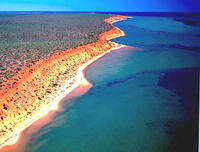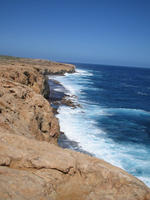You are in: Oceania -> Australia -> Shark Bay, Western A... , and traditional search or Image Gallery will yield results of this site only
Shark Bay, Western Australia
| Site number: | 578 |
|
| Type of site: | Natural | |
| Date of Inscription: | 1991 | |
| Location: | Australia, State of Western Australia | |
Up to 75 images are shown here. Click on each for more details or on Image Gallery for more images.
| Description: | Shark Bay, with its islands and surrounding land, is located at the farthest western point on the Australian continent. The bay features three unprecedented natural features: the world's largest (4,800 km2) and richest sea-grass beds; populations of dugong ('sea cow'); and the earth's oldest life-forms: stromatolites (algae colonies which form hard, dome-shaped deposits). Five species of endangered mammals reside in Shark Bay. --WHMNet paraphrase from the description at WHC Site, where additional information is available. | |
| Shark Bay is a world heritage site and a locality in the Gascoyne region of Western Australia. It is located over 800 km north of Perth, on the westernmost point of Australia. It was named by William Dampier, one of the first Europeans to visit Australia in July 1699. Shark Bay lays claim to being the first place of European contact in all Australia with Dirk Hartog's landing in 1616 and thus the first place of 'discovery' in a formal and documented manner by the outside world. The bay's western arm is called Denham Sound. Shark Bay may refer to: the bay itself, along with its peninsulas and numerous islands, the Shire of Shark Bay, the Shark Bay World Heritage Site, the Shark Bay Marine Park. It may help the reader to understand the reality of such isolated and vast localities of Australia by comparing it to a country of an equivalent area in Europe such as Wales: Shark Bay is about the same size but has a population of fewer than 1,000 people and a coastline of over 1,500 kilometres. The half dozen small communities making up this population occupy less than 1% of the total area. --Wikipedia. Text is available under the Creative Commons Attribution-ShareAlike License. | ||
| Source: | http://whc.unesco.org/en/list/578 | |
| Source2: | http://whc.unesco.org/en/list/578/video | |
| Reference: | 1. UNESCO World Heritage Center, Site Page. | |


















